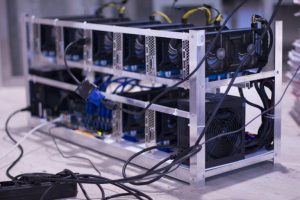Senator Durbin Unhappy With ‘Obscene Amounts of Electricity’ Needed for Crypto Mining

On Saturday (July 16), U.S. Senator Dick Durbin made it very clear that he is not happy with the energy consumption of crypto mining.
Senator Dick Durbin, is “a Democrat from Springfield, is the 47th U.S. Senator from the State of Illinois, the state’s senior senator, and the convener of Illinois’ bipartisan congressional delegation.” He “serves as the Senate Majority Whip, the second highest ranking position among the Senate Democrats.” Senator Durbin has been “elected to this leadership post by his Democratic colleagues every two years since 2005.” Also, Durbin is Chair of the Senate Judiciary Committee, and sits on the Appropriations and Agriculture Committees.
Yesterday, Senator Durbin tweeted abut the “obscene” energy costs of crypto mining:
One of those that responded to Senator Durbin was Darin Feinstein, Co-Founder of crypto mining solution provider Core Scientific (NASDAQ: CORZ).
On January 20, U.S. House of Representatives Energy and Commerce Committee discussed the environment impact of crypto mining’s energy consumption:
https://youtube.com/watch?v=NlB0sqzvYfo%3Ffeature%3Doembed
On March 28, Nic Carter, a Partner at Castle Island Ventures, and Troy Cross, a Fellow at the Bitcoin Policy Institute, talked to journalist Peter McCormack for an interview for episode 481 of the very popular “What Bitcoin Did” podcast.
Here is what Carter said about crypto mining companies:
“Yeah, so a lot of mining companies are publicly traded. There’s maybe 30 in the US alone. And so, by law, they have to disclose all the material facts about their operation, which is really interesting actually. That was not the case two years ago. There were all these miners in China we didn’t know anything about, so that’s a great development. So, there’s a bunch of different models with mining, they’re not all doing the same thing. Many of them are very focused on sustainability, not just because of a capital markets thing, and because being pro-ESG is going to help them with the SEC, or whatever; but just because it’s the right thing to do and because miners have the ability to be discretionary in terms of where they secure energy from. They can buy energy from anywhere.
“The main one I’ve seen is just hydro and locating in areas where there was a mismatch between the supply of energy and then the demand. So, places where maybe industrial production dropped off, like Quebec would be a good example, British Columbia, Washington State, upstate New York; these were places where there were big industrial sources of demand for cheap energy. And then, whatever those industries were, like paper-pulping, aluminium-smelting, there was a case of a hockey stick factory in Quebec which is now a Bitcoin mine, those industries left, because we can’t predict what the nature of demand is going to be 30 years from now, but energy gets amortised over new energy installations, they have that kind of lifetime.
“So, these mismatches occur, and so then you have huge sources of supply, especially upstate New York, Quebec, Canada, things like that, with hydro and no demand, because all the industries went to China, or whatever, they just got outsourced. So, that’s the first one, that’s very straightforward. You can effectively complete completely hydro based energy, and there absolutely are miners that do that.
“The more complex and interesting one, I think, is where miners will co-locate with renewable energy assets, like wind or solar, and these are assets often times that are distressed in some way, because you might have a windfarm that gets built, and then on the plots of land all around that windfarm, you have three more windfarms get built. And so, you then have a correlated generation, where they’re all trying to sell energy to the grid at the same time, and there’s no one there that wants to buy it. And you might have a situation like West Texas, where there’s transmission bottlenecks, where you’ve got 35 gigawatts of load on a sunny, windy day, and only 5 gigawatts of local demand, and only 12 gigawatts of long-term transmission to the rest of the state, so you can’t even really export all the energy. So then, the energy asset owners can’t sell it.
“At that point, that’s where Bitcoin miners come in. They say, ‘We’re going to put a mine next to this windfarm so you’re not going to have to pay any transmission fees’, so the energy’s going to be really cheap for them. However, they can’t run their operations on a solar or wind asset 100% of the time, because the wind doesn’t always blow and the sun doesn’t always shine, so that’s when it’s more complex. At that point, they will engage in grid firming. They will pull energy from the grid to make up whatever the remaining percentage is; and at that point, they’ll just get the default grid mix.
“So, it’s not a story of 100% pure sustainability, because if you trace the electrons, you’ll be able to trace them back to some more carbon-intense sources of generation, like natural gas; but what you are doing is rescuing the economics of renewables that are stranded, and you’re allowing a structural overpenetration of renewables on the grid, which I think is good. And so, you’ll get that in Texas. Texas is a great case study; they’re piling wind and solar onto the grid right now in huge, huge amounts.“
https://youtube.com/watch?v=qu156PvA-NI%3Ffeature%3Doembed
Image Credit
Featured Image by rebcenter-moscow from Pixabay
Source: Read Full Article
